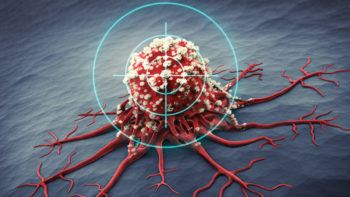Texas A&M Researchers Report Fastest Purification Of Cancer Therapy Isotope
Astatine-211, a candidate for targeted alpha-particle therapy, decays in hours. Researchers have delineated a purification process that can extract it in minutes, increasing the amount of the element available for use.

In a recent study, Texas A&M University researchers have described a new process to purify astatine-211, a promising radioactive isotope for targeted cancer treatment.
Unlike other elaborate purification methods, their technique can extract astatine-211 from bismuth in minutes rather than hours, which can greatly reduce the time between production and delivery to the patient.
“Astatine-211 is currently under evaluation as a cancer therapeutic in clinical trials. But the problem is that the supply chain for this element is very limited because only a few places worldwide can make it,” said Jonathan Burns, research scientist in the Texas A&M Engineering Experiment Station’s Nuclear Engineering and Science Center. “Texas A&M University is one of a handful of places in the world that can make astatine-211, and we have delineated a rapid astatine-211 separation process that increases the usable quantity of this isotope for research and therapeutic purposes.”
The researchers added that this separation method will bring Texas A&M one step closer to providing astatine-211 for distribution through the Department of Energy’s Isotope Program’s National Isotope Development Center as part of the University Isotope Network.
Details on the chemical reaction to purify astatine-211 in the journal Separation and Purification Technology.
Astatine is one of the least abundant elements on Earth. Furthermore, it is short-lived, undergoing quick radioactive decay by releasing positively charged alpha particles to achieve nuclear stability. Hence, astatine, particularly its isotope astatine-211, is an attractive candidate for a form of radiation therapy for cancer treatment, called targeted alpha-particle therapy.
Unlike other forms of radiation that can penetrate deeper into the body, damaging both healthy and cancerous tissue, alpha particles travel a short distance and lose their energy. When astatine-211 is positioned in or near cancerous tissue, its emitted alpha particles travel deep enough to destroy the cancer cells but leave healthy tissue minimally harmed. Also, the short half-life of astatine-211, or time taken for half of its atomic nuclei to decay, means that it loses its radioactivity quickly and is less toxic than other radiopharmaceuticals that are long-lived.
Burns noted, however, that the half-life of astatine is a double-edged sword. Since the element has a very low natural abundance, astatine-211 is artificially made by bombarding bismuth with high-speed alpha particles. Once created, astatine-211 begins to decay immediately, he said, starting the clock on how long it will last.
“Every 7.2 hours, half of the produced astatine-211 decays away and is no longer usable for treatment,” Burns said. “So, the time taken from when it’s produced to when it can go into the patient becomes very critical. If a purification process takes four hours, for example, that means it’s around half of astatine’s half-life; you’ve lost a third of the material you’ve made.”
In an attempt to simplify the purification process, Burns and his colleagues sought to use nitric acid for extracting the astatine-211 from bismuth. For their experiments, they filled a chromatography column that is often used for separating mixtures with tiny, porous beads infused with organic chemicals called ketones.
Next, the researchers made astatine-211 by bombarding bismuth with alpha particles at the Texas A&M University Cyclotron Institute. They then dissolved the bismuth in nitric acid. When they passed this solution through the chromatography column, the researchers found that only astatine-211 formed a chemical bond with the ketones. Furthermore, since the ketones are hydrophobic, they were repelled away from nitric acid, sticking to the beads. The net effect was that bismuth passed through the column, whereas pure astatine-211 remained collected within the beads.
This procedure, the researchers found, takes roughly 10 to 20 minutes, unlike other astatine purification processes that can take hours.
Although a cyclotron is needed in producing medical-grade astatine-211, Burns said many hospitals are already equipped with a machine for producing other chemicals, like fluorodeoxyglucose F 18 that is needed for positron emission tomography. But even for hospitals that might rely on astatine-211 delivery from an offsite location, the short purification procedure offers more time for transportation.
“Texas A&M University, for example, is in a really nice geographical location, we’re right in the middle of five of the top 20 largest cities in America and we’re right next to one of the major cancer centers in the United States,” Burns said. “We are aiming to produce, purify, and ship astatine in batches large enough for pre-clinical and clinical trials. We are not there yet, but we have made significant progress through this elegant separation technique.”
Other contributors to the research include Evgeny Tereshatov, Geoffrey Avila, Kevin Glennon, Andrew Hannaman, Kylie Lofton, Laura McCann, Mallory McCarthy, Lauren McIntosh, Steven Schultz, Gabriel Tabacaru, Amy Vonder Haar andSherry Yennello from the Cyclotron Institute at Texas A&M.
The research is funded by the United States Department of Energy Isotope Program, managed by the Office of Science, Texas A&M University through the Bright Chair in Nuclear Science, The Texas A&M System National Laboratories Office and U.S. Department of Energy.
Publication: Jonathan D. Burns, et al., Rapid recovery of At-211 by extraction chromatography, Separation and Purification Technology (2023). DOI: 10.1016/j.seppur.2020.117794
Original Story Source: Texas A&M University

 Alerts Sign-up
Alerts Sign-up